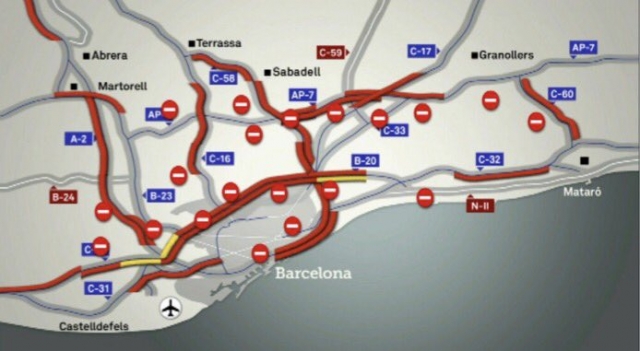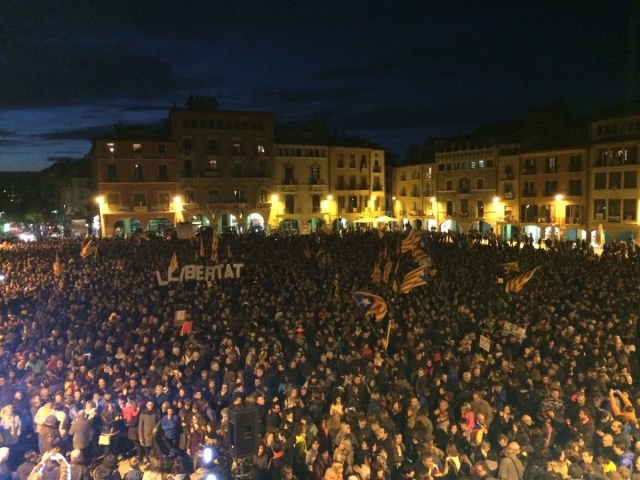The Catalan general strike against repression, article 155 intervention and for the release of the political prisoners managed to paralyse the country. Despite all difficulties, the strike had a large following in education, the public sector and the media, but was almost non-existent in industry and transport. However, the day was marked by mass road and transport blockades organised by the Committees for the Defence of the Republic (CDRs) and mass demonstrations in all cities and towns.
The strike had been called as part of the protests against the jailing of 8 members of the Catalan government remanded in custody on charges of rebellion, sedition and misuse of public funds, for their part in the Catalan independence referendum of October 1. The legal call for strike had been issued by a small union with little representation (I-CSC), but then had gained support of other unions like COS (a small pro-independence union) and IAC (which includes USTEC, the majority union amongst teachers in Catalonia, and CATAC, the majority union amongst Catalan civil servants). The CGT Catalunya, which had played a key role in the previous general strike against repression on October 3, this time had no time to go through the full process of consulting its members, but many of its regions and federations did come out in favour (including their education federation, the Tarragona and Lleida regions, the Barcelona Metalworkers Union, etc). The student movement, led by Universities for the Republic, also joined in the strike call.
There were obvious difficulties in calling for a strike which was openly political without the support of the two main trade union confederations (CCOO and UGT), which didn’t even pretend to support it like they did on October 3, and there was very little time to organise it. Additionally, the main Catalan bosses organisation Foment, issued a legal challenge on the grounds that this was a political strike (and therefore banned under Spanish labour law). The Court did not rule on the challenge up until the eve of the strike itself and then Foment appealed to a higher court, which also threw it out. As a result there was uncertainty about the legality of the strike until the very last minute. The attitude of the Catalan bourgeois has been clear from the beginning, they are against independence and particularly they are against anything to do with mass mobilisation and strikes. The Comuns took a scandalous position of not supporting the strike for democratic rights on the grounds that “it was not sufficiently broad based”.
On the day, the strike had a large following in education where 80% stopped according to the organisers and amongst Catalan civil servants, 40% of whom struck. Workers at the Catalan state owned media (TV3, Catalunya Radio, etc) who are under direct threat of article 155 intervention, also voted to strike in mass assemblies. The public health care system was also affected and there was a widespread shut down of small shops and businesses. However, it was clear that the strike had an extremely limited following in industry and transportation.
Aquest és el camí! defensant la República Catalana.
— Assemblea Cunit (@AssembleaCunit) November 9, 2017
Dissabte a omplir la manifestació! #llibertatPresosPolítics ! #SomRepública !https://t.co/bxg14PLdGF www.pic.twitter.com/N9royP6a21
One of the focal points of the day’s protests was the road and transportation blockades organised by the Committees for the Defence of the Republic. This was really the first time that the national coordination of CDRs was organising an independent action and it was a big success. From early in the morning 50 major roads were blocked across Catalonia, each road blockade manned by hundreds of people. These road blockades included the main motorways linking Catalonia with France and Valencia, as well as major roads leading into Andorra and Aragon. In the province of Barcelona most major highways were blocked at point or another. In Barcelona itself main streets were blocked as well as the main coach station.
 Map of all blocked roads throughout Barcelona
Map of all blocked roads throughout Barcelona
C-58 a #Sabadell tallada en ambdós sentits!#VagaGeneral8N #LlibertatPresosPolítics#CDRenXarxa www.pic.twitter.com/CW3v1AkAIy
— @CDRSabadell (@cdrsabadell) November 8, 2017
In Girona about 500 people broke through police lines to occupy the main train station and stopped the circulation of AVE high speed trains throughout the day. Barcelona’s main train station was blocked in the late afternoon by a demonstration of hundreds of students which also managed to bring to a halt the AVE trains. The police then shut down the station and moved to remove the protesters, but they were supported by hundreds who gathered outside and finally those trapped inside could escape through a fire exit.
Girona:
Una riuada de gent desborda el cordó dels mossos i baixa a les vies de l'AVE a Girona. Circulació aturada. #VagaGeneral8N www.pic.twitter.com/Ln6qpKdLUB
— VAGA GENERAL (@erik_stny) November 8, 2017
Barcelona Sants:
Les estudiants paralitzem l'estació de Sants. Ni la por ni la repressió ens aturaran, per la dignitat d'aquest poble! #VagaGeneral8N www.pic.twitter.com/JsOllyBtdW
— SEPC #VagaGeneral (@SEPC_nacional) November 8, 2017
There were no major incidents with the police during the day, though National Police vans charged at a road blockade in Gran Via in Barcelona and the Catalan Mossos riot police attacked a couple of the blockades and forcibly removed blockaders from Barcelona’s coach station. The Catalan Mossos are now under direct command of the Spanish government, but throughout the day it seemed that the general attitude of the police, faced with a large scale mobilisation was one of not intervening so as not to inflame the situation further.
Ells tenen la força. Nosaltres, la raó!!
— CDR Poblenou #CDRP9 (@CDRPoblenou) November 8, 2017
Resistim!!#Llibertatpresospolitics #LlibertatPresosPoliticsCatalans #VagaGeneral8N pic.twitter.com/pQCM4KAqBz
Ara mateix els @mossos desallotjant-nos per la força de l'accés a Ronda Litoral #vagageneral8n pic.twitter.com/JYwRWvOM2P
— CDR de Sant Antoni (@CDR_SantAntoni) November 8, 2017
Gran Via:
Ara mateix Gran via Poblenou #carrega www.pic.twitter.com/Ly8DUB1iDh
— FRANCESC *X (@CAT_Francesc) November 8, 2017
At noon there were mass demonstrations in many cities and towns, including one which filled the whole of Sant Jaume Sq in Barcelona. Columns organised by neighbourhood CDRs were converging into the centre of the city. In Mataró, 3,000 gathered and then marched to blockade a nearby highway. In Sabadell 3,000 marched at noon. In Terrassa there were 10,000 at the rally.
Barcelona, Pça Sant Jaume:
? Protesta en Plaza Sant Jaume para pedir la liberación de exconsellers y 'los Jordis'. #VagaGeneral8N #directo pic.twitter.com/SqJYoexgnb
— La Vanguardia (@LaVanguardia) November 8, 2017
Column from Sants marching:
Una columna de manifestants surt de #Sants en direcció a plaça de Sant Jaume @La_Directa pic.twitter.com/qMTjZ512Ob
— Jesús Rodríguez (@albertmartnez) November 8, 2017
Mataró:
Autopista totalment tallada per part de la manifestació convocada pel @CDRMataro pic.twitter.com/V4ybDZyAug
— El Tot Mataró (@totmataro) November 8, 2017
Sabadell:
VIDEO La manifestació de la vaga general a #sabadell concentra unes 3.000 persones https://t.co/lvWXkqdDrD pic.twitter.com/LmTaenyEGq
— NacióSabadell (@NacioSabadell) November 8, 2017
Terrassa
Una riuada humama, el poble treballador i les classes populars desborden totes les previsions milers de persones es manifesten al carrers de #Terrassa Unes 10.000! #Llibertatpresospolitics #VagaGeneral8N#8NVagaGeneral#AturadaRac1 pic.twitter.com/GuxIJNBPoV
— Manel Márquez (@manelmarquez) November 8, 2017
In the late afternoon the CDRs advised everyone to strengthen the road blockades in the main roads leading in and out of Catalonia (Operació Fronteres, they called it), and again hundreds responded to the call, travelling long distances to help those who had already been blockading them since before dawn.
In the evening there were again huge demonstrations in all towns and cities. Tens of thousands packed Avinguda de la Catedral in Barcelona. The mood was no longer one of euphoria and celebration, but a serious one of resoluteness and militancy. The general secretary of the Catalan UGT Camil Ros was whistled and booed because of the position of his union of not supporting the general strike call. A representative of the CDRs spoke, giving the most militant speech which was very well received. She stressed the importance of popular organisation: “this must be a Republic of those from below, not those from above”, she said, “we must keep coming out to the streets as without us there’s no Republic”.
Thousands filled the main Mercadal Sq in Reus, once again. Thousands also rallied in Vic, Manresa, Lleida, Vilanova i la Geltrú, Vilafranca, Manresa and dozens of other towns and cities.
Reus:
#Reus demana #Llibertatpresosolitics @ANC_Reus @omniumbaixcamp pic.twitter.com/T2jDXH44g1
— Ramon Masip (@ramon_masip) November 8, 2017
Vic:
Així sona 'Els Segadors' en una Plaça Major de Vic plena de gom a gom @OmniumOsona @omnium @assemblea @AssembleaOsona @ANC_Vic pic.twitter.com/W7bHIk3sMi
— Canal Taronja Osona (@TaronjaOsona) November 8, 2017
Manresa:
Ajuntament de Manresa, ara mateix pic.twitter.com/cKymdqDM6i
— Brainwave (@forgettingatall) November 8, 2017
Lleida:
Feia molt fred, molt.
— Postureig de Lleida (@PostureigLleida) November 8, 2017
Però més en fa a la presó.
Un cop més, orgullós de #Lleida i #Ponent, sou #Lleidatanament grans! #LlibertatPresosPolítics pic.twitter.com/vjokDiZMKk
Vilanova i la Geltrú:
I de nou la plaça plena i de nou la democràcia no hi és a les institucions, està al carrer. Vilanova i la Geltrú amb la #VagaGeneral8N per exigir #LlibertatPresosPolítics pic.twitter.com/QPxn4AWujx
— Enver Aznar Méndez (@EnverAzMe) November 8, 2017
Vilafranca:
Vilafranca #VagaGeneral8N pic.twitter.com/koaWsVTEwX
— Ésser Liminoide ?? (@un_esser) November 8, 2017
Manresa:
#VagaGeneral8N LLIBERTAT!!! Manresa. pic.twitter.com/eoxQVNBdgU
— Miquel Leon Pardo (@miqueleo) November 8, 2017
The day closed with the final lifting of the main road blockades. The border with France at Puigcerdà was not reopened until early this morning. For the tens of thousands who had taken part in the actions this had been a very long day, but one in which the idea of the power of the mobilised masses dominated everyone’s minds.
#EnMoviment El @CDRepublicaVic informa que s'acaba de decidir en assemblea aixecar el tall de Puigcerdà després de més de 24 hores de fred i neu i d'una jornada de vaga amb totes les fronteres tancades. Ha estat l'últim tall en aixecar-se pic.twitter.com/IDU9uge4uc
— Setembre (@elsetembre) November 9, 2017
The Committees for the Defence of the Republic had shown their strength and their ability to organise in a day in which they, together with small trade unions, bore the brunt of the mobilisation. That is a very important step forward.
All the attention is now centered on the demonstration on Saturday in Barcelona, called by the ANC and Òmnium, which they expect to be of a similar size compared to the massive rallies of Catalan national day, in which between one and two million people have demonstrated over the last 5 years.
State repression has not stopped the movement for a Catalan republic, on the contrary. Whilst most political leaders are concentrated on the question of how to contest the December 21 Catalan elections (called through article 155 disbanding the Catalan parliament), the masses on the streets have shown once again their willingness to struggle. Now they have a tool of their own: the CDRs.

